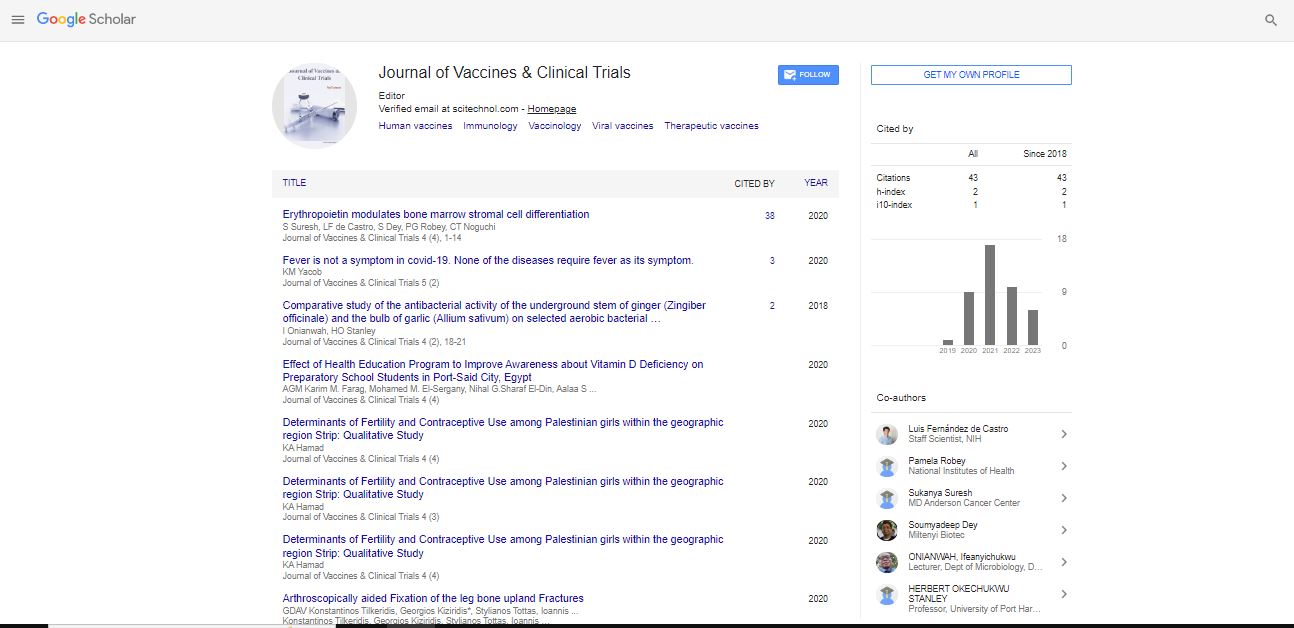Perspective, Jou Of Vac Cli Tr Vol: 7 Issue: 1
DNA Vaccines in Bats: A Promising Approach to Combat Emerging Viral Diseases
Salena Fellies*
1Department of Dermatology, Venerology and Allergology, The University of Sydney, Sydney, Australia
*Corresponding Author: Salena F
Department of Dermatology, Venerology and Allergology, The University of Sydney, Sydney, Australia
E-mail: Felliesalie@gmail.com
Received date: 24 February, 2023, Manuscript No. JVCT-23-92755;
Editor assigned date: 28 February, 2023, PreQC No. JVCT-23-92755(PQ);
Reviewed date: 13 March, 2023, QCNo JVCT-23-92755;
Revised date: 21 March, 2023, Manuscript No. JVCT-23-92755 (R);
Published date: 30 March, 2023, DOI: 10.4172/JVCT.100062.
Citation: Fellies S (2023) DNA Vaccines in Bats: A Promising Approach to Combat Emerging Viral Diseases. Jou of Vac Cli Tr 7:1.
Description
DNA vaccines have emerged as an important method of vaccination for animals. These vaccines work by introducing a plasmid that contains the DNA encoding the antigen(s) of interest into the host cells. The cellular machinery of the host cells then produces the antigen, which triggers an immune response in the animal's body.
One of the advantages of DNA vaccines is that they can induce both humoral and cellular immune responses, leading to a more robust and long-lasting immune response. Furthermore, because the antigen is produced within the host cells, DNA vaccines are not dependent on the use of live or attenuated pathogens, which can cause safety concerns.
Proof of the principle of DNA vaccination has been demonstrated in animals using genes from a variety of infectious agents. For example, DNA vaccines have been used to protect animals against diseases such as foot-and-mouth disease, avian influenza, and swine fever. Overall, DNA vaccines have the potential to revolutionize the field of animal vaccination by providing a safe and effective method of protection against infectious diseases.
Bats are known to be natural reservoirs of several emerging viral diseases that pose a threat to human and animal health. As such, the development of effective vaccines against these diseases is of utmost importance. DNA vaccines are a promising approach to combat these emerging viral diseases.
DNA vaccines have several advantages over traditional vaccines. Firstly, they are easy to produce and can be rapidly manufactured in large quantities. Secondly, they are safe and do not require the use of live or inactivated viruses, which can pose a risk of reversion to virulence. Thirdly, they can induce both humoral and cellular immune responses, which are important for protection against viral infections.
Bioengineering-based vaccine development approaches can be used for respiratory viral diseases. These approaches are classified based on the biomaterial used. For instance, Virus-Like Particles (VLPs) have been used as a biomaterial to develop vaccines against Respiratory Syncytial Virus (RSV) and influenza. VLPs are non-infectious particles that mimic the structure of the virus, and can thus elicit an immune response without causing disease.
Another biomaterial that has been used to develop vaccines against respiratory viral diseases is nanoparticles. Nanoparticles can be designed to deliver antigens to specific cells in the body, resulting in a more targeted immune response. For example, nanoparticles have been used to deliver DNA vaccines against influenza and RSV.
In the case of bats, DNA vaccines have been shown to be effective in protecting against several viral diseases. For instance, a DNA vaccine against Hendra virus, a deadly virus that can be transmitted from bats to humans has been shown to be effective in protecting horses from the disease. Similarly, a DNA vaccine against Nipah virus, another bat-borne virus that can cause severe respiratory illness and encephalitis in humans, has been shown to be effective in protecting pigs from the disease.
The results suggest that DNA vaccines can be an effective tool in the fight against emerging viral diseases in bats. However, further research is needed to determine the safety and efficacy of these vaccines in humans. In conclusion, DNA vaccines offer a promising approach to combat emerging viral diseases in bats. Bioengineeringbased vaccine development approaches can be used to enhance the effectiveness of these vaccines. The development of effective vaccines against these diseases is crucial to protect human and animal health, and to prevent future pandemics.
 Spanish
Spanish  Chinese
Chinese  Russian
Russian  German
German  French
French  Japanese
Japanese  Portuguese
Portuguese  Hindi
Hindi 